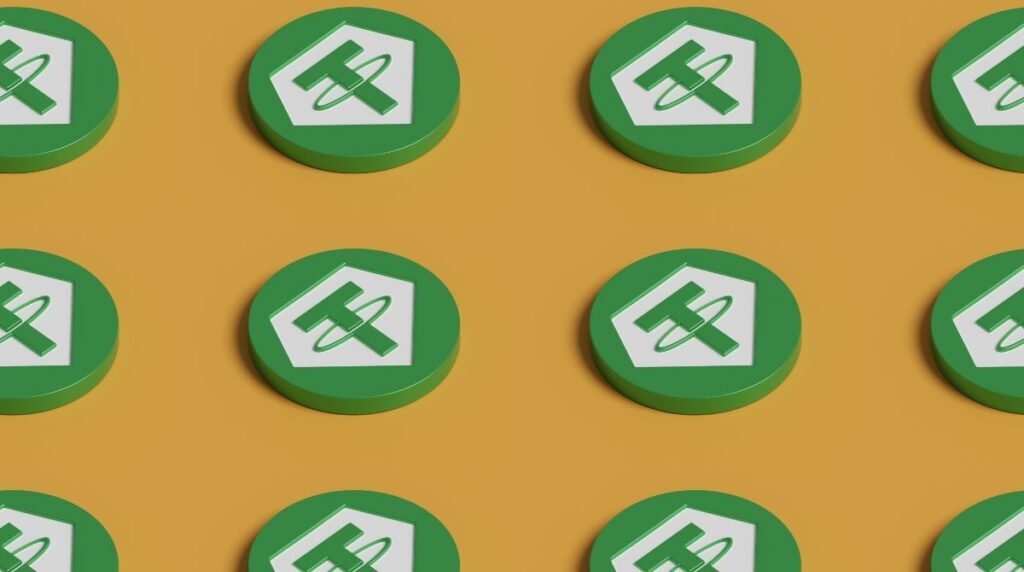Tether is a well-known name in the world of cryptocurrency, often recognized as a cornerstone of the digital currency ecosystem.
With a primary focus on stability, Tether aims to provide a safe and reliable digital currency option. Many investors turn to Tether because it operates differently from traditional cryptocurrencies and serves unique purposes in the market.
What we’ll cover
What is Tether?
Tether is a type of cryptocurrency known as a stablecoin. Stablecoins are designed to maintain a stable value by pegging them to a reserve of real-world assets, often fiat currencies like the US dollar.
Each USDT, Tether’s official token, is meant to be backed by one US dollar. This structure allows users to hold and transfer value without the high volatility typically associated with cryptocurrencies like Bitcoin.
History and development of Tether
Tether’s roots go back to 2014 when it was first introduced as Realcoin. The creators—Brock Pierce, Reeve Collins, and Craig Sellars—saw a gap in the market for a stable digital currency. While Bitcoin and Ethereum were volatile, they believed a cryptocurrency linked to the US dollar could offer more reliability.
The project quickly rebranded to Tether and launched its first tokens on the Bitcoin blockchain via the Omni Layer protocol. The aim was to merge the convenience of digital assets with the confidence of fiat money.
Over time, Tether expanded its reach by issuing USDT on multiple blockchains, including Ethereum, Tron, Solana, and others. This made Tether more versatile and faster to use across networks.
Today, it’s the most widely used stablecoin in terms of trading volume and is accepted across nearly all major crypto platforms.
How Tether works
Tether operates by maintaining a balance of reserves. The company claims to keep reserves equivalent to the total amount of USDT in circulation.
Users can redeem 1 USDT for $1, making it a stable digital asset. This peg allows traders to move in and out of more volatile cryptocurrencies easily.
When you buy Tether, you are essentially buying a promise that your token holds its value relative to fiat currency.
How stablecoins like USDT are structured
Stablecoins come in several types based on how they maintain value:
- Fiat-collateralized stablecoins (like USDT and USDC): Backed by real-world assets held in reserve.
- Crypto-collateralized stablecoins (like DAI): Backed by other cryptocurrencies and managed by smart contracts.
- Algorithmic stablecoins: Use software to adjust supply and demand, often without collateral. These are riskier and less common after several project failures.
Tether falls under the first type. Its stability relies on the company’s ability to maintain reserves and honour redemptions. Tether Limited publishes reports to show the breakdown of its assets, including cash, bonds, and other financial instruments.
Advantages of using USDT
Tether has become a go-to digital asset for several reasons:
- Low price volatility: Unlike Bitcoin or Ethereum, USDT stays close to $1.
- Fast and cheap transfers: Especially on blockchains like Tron or Solana.
- Wide acceptance: Almost all crypto services, wallets, and exchanges support USDT.
- Multiple blockchains: Users can choose a network that suits their needs in terms of speed and cost.
For everyday users, USDT acts like a digital version of the dollar that’s easy to use and widely available.
How Tether supports the crypto economy
USDT isn’t just a trading tool. It plays several roles in the wider cryptocurrency economy:
Liquidity for exchanges
Many exchanges use USDT as a base trading pair. This helps create smoother markets, even when trading less popular cryptocurrencies.
Easier crypto onboarding
People new to crypto often start with Tether. It gives them a familiar way to interact with digital assets—especially in countries where local currency is unstable or hard to convert.
Cross-border payments
Tether allows users to send digital dollars across borders in minutes, with low fees. This has become popular for freelancers, remote workers, and users in developing countries who want a dollar-pegged asset.
Staking and interest
Some platforms offer interest on USDT deposits through cryptocurrency staking. You can lend your USDT or join savings programs that pay regular returns. While these aren’t risk-free, they’re often more stable than returns on volatile crypto coins.
Long-term predictions for Tether
The future of Tether remains a topic of debate among crypto enthusiasts.
Its strong market presence and backing by real-world assets suggest it will continue to play an important role in the cryptocurrency ecosystem.
However, regulatory scrutiny is increasing, and how Tether aligns itself with government regulations could impact its long-term viability. Predictions vary, but many believe that as long as Tether maintains its peg and transparency, it will remain popular.
Controversies and transparency concerns
Tether has faced criticism over the years, mostly about whether it truly holds enough reserves to back every USDT in circulation. In 2021, the company settled with the New York Attorney General, agreeing to improve its transparency and stop serving New York residents.
Since then, Tether has published regular breakdowns of its reserve holdings. These reports show a mix of assets—such as short-term government securities, secured loans, and cash. While some investors remain cautious, others accept this structure as reasonable given its high liquidity.
Transparency remains a hot topic, and it’s one area where rivals like USDC have tried to set themselves apart.
Similar coins like USDC
In addition to Tether, other stablecoins like USDC offer similar features but differ in underlying mechanisms and trust factors.
USDC, for example, is known for its strict regulatory compliance and frequent audits. Users looking for alternatives often compare features of Tether and USDC to determine which best suits their needs. Each has its advantages, and the choice largely depends on individual preferences and requirements.
How to get USDT
Obtaining USDT is straightforward. You can buy Tether on major exchanges with fiat or cryptocurrency.
Some of the most popular platforms include Binance, Coinbase, and Kraken.
Alternatively, you can also consider collecting free USDT through crypto faucets, which reward users for simple tasks or participation. These faucets can be a fun way to learn about Tether while accumulating small amounts of the cryptocurrency.
FAQs about Tether
What is Tether used for?
Tether is primarily used for trading and exchanging between different cryptocurrencies, acting as a bridge for liquidity. Traders often use USDT to hedge against market volatility, allowing them to park value without converting back to fiat currency. Additionally, it’s used in decentralized finance (DeFi) applications, lending and borrowing platforms to facilitate transactions and earn interest.
How does Tether maintain its value?
Tether aims to maintain its value by being backed by reserves of real assets. For every USDT issued, Tether claims there is an equivalent amount of fiat currency or assets stored. This backing is meant to ensure that the token retains its 1:1 peg with the US dollar, providing users a stable digital currency. However, this aspect has raised questions about transparency, which Tether continues to address.
Can you buy Tether on exchanges?
Yes, you can buy Tether on many cryptocurrency exchanges like Binance, Coinbase, and Kraken. You can purchase USDT using fiat money, such as USD, or swap it with other cryptocurrencies. Simply create an account, deposit funds, and choose Tether from the marketplace to complete your transaction.
Are there any risks associated with Tether?
While Tether provides a stable asset, there are risks involved. Questions about reserve transparency and regulatory scrutiny are key concerns that may affect its future. Users should also understand that, like any asset, the market can change rapidly. It’s important to stay informed and consider the potential risks before investing or using USDT.



